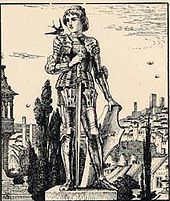The happy prince
The Happy Prince (Engl. The Happy Prince ) is a literary fairy tale by Oscar Wilde . It was first published in 1888 as the cover story of the prose collection The Happy Prince and Other Fairy Tales .
content

The statue of the happy prince stands high above a town on a slender column . She is covered with gold leaf , her eyes are sapphires and a ruby is her sword pommel . During his lifetime, the happy prince was admired by everyone because he was always cheerful. As a statue he now notices the misery of the city. When a "little swallow" sits down at the prince's feet to sleep on her way to Egypt , a tear struck her from the happy prince's eye. The prince tells the swallow about a poor seamstress whose son is sick and asks her to pick the ruby from the hilt of the sword and bring it to the mother to help her. After a brief contradiction, it does so. The swallow wants to say goodbye the next day, but the prince asks her for another favor. She is supposed to bring the sapphires out of his eyes to a helpless poet and a match seller who has dropped her matches into the gutter . Since the prince is now blind, the swallow decides to stay with him and see for him. The prince asks to pick the gold off his body and distribute it under the arms. The swallow does the prince this favor and distributes the gold among the orphans . In the meantime it has become winter, the swallow freezes to death and the statue of the prince is now so unsightly that it is being torn down and melted down. But the prince's heart does not melt in the oven and is thrown onto the garbage where the dead swallow is already lying. When God asks an angel to get him the two most precious things there are in the city, he brings him the leaden heart and the dead bird. God wants them both in his garden - the swallow should sing and the happy prince should praise God.
reception
- 1909: The Spanish translation of the fairy tale was published for the first time by Jorge Luis Borges, who was nine years old at the time .
- 1946: The Happy Prince. Radio play version with Orson Welles as narrator and Bing Crosby as prince on Decca Records .
- 1974: The Happy Prince . Canadian cartoon with Christopher Plummer as narrator.
- 1985: The happy prince. Radio play version by Carmen Blazejewski for radio in the GDR .
- 1999: The Happy Prince. American television film by HBO with Cyndi Lauper as Schwalbe.
- 2000: The happy prince. Opera adaptation by Wolfgang Böhmer and Peter Lund at the Neukölln Opera .
Clifton Snider wrote: “... Wilde must have had London in mind as the setting for his story, because the descriptions correspond to contemporary London. But we only know that the happy prince stands above a 'big city' 'somewhere in Northern Europe' and that he lived in Sanssouci ['worry free'] which is the name of the palace of Frederick the Great . ... " .
Tobias Wenzel wrote on Deutschlandradio Kultur in his review of an audio book version published in 2005: "It is probably the most beautiful fairy tale that Oscar Wilde wrote."
Individual evidence
- ^ Jorge Luis Borges, Norman Thomas di Giovanni: Autobiografía 1899-1970 . El Ateneo, Buenos Aires 1999, pp. 30 ( ignaciodarnaude.com [PDF]).
- ↑ www.youtube.com
- ↑ Peter Bogdanovich : This is Orson Welles speaking. Beltz Quadriga, Weinheim, Berlin 1994, ISBN 3-88679-228-5 , p. 550.
- ↑ Internet Movie Database (accessed December 6, 2011)
- ↑ Oscar Wilde - The Happy Prince. ARD audio game database, accessed on February 22, 2018 .
- ↑ Internet Movie Database (accessed December 6, 2011)
- ↑ Felix Bloch Erben (accessed December 6, 2011)
- ↑ “… Wilde must have had London in mind as the setting for his story, for the descriptions match those of contemporary London. All we know, however, is that the Happy Prince stands above a 'great city' somewhere 'in the north of Europe' and that he had lived in Sans-Souci, the name of Frederick the Great's palace at Potsdam,… ” On the Loom of Sorrow. Eros and Logos in Oscar Wilde's Fairy Tales. (Accessed December 6, 2011)
- ↑ www.dradio.de ( accessed on December 6, 2011)
Web links
- Full text (English) in Project Gutenberg
- German translation by Alice Seiffert in the Gutenberg-DE project